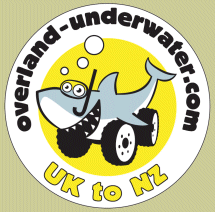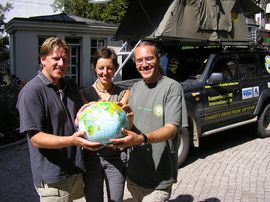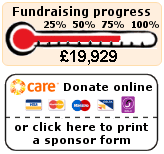| Final Statistics: Alex & Maz | Total distance: 93,550km |
| Furthest Point: Rotorua, NZ | Now settled in Sydney, Australia |
| Final Statistics: Martin | Total distance: 79,698km |
| Furthest Point: Hobart, Australia | Now settled in Bristol, UK |
Abandoned French heritage and we leave Cambodia
Cambodia, Country 21, Diary entry 13th-22nd May 2006, Total distance in Cambodia : 2478km
The final part of the Ian Pitwood trilogy. Thanks for the help in getting the diaries up to date (even if we still haven't managed it!).
We found our way out of Phnom Penh and onto the Sihanoukville road. It was our intention to spend a few days touring along the Cambodian coast. The journey, for the most part, was across flat featureless countryside passing rice fields and plantations of all sorts. We were unable to identify most of the foodstuffs being grown as the plants were unfamiliar to us. At lunchtime, we pulled off the road alongside one of the plantations, planted with short stubby palm trees. On closer inspection the trees appeared to be growing dates but being unwilling to pick and try one, this is only assumption. If we are right, goodness knows what happens to them as we've not seen them in the markets. Probably they're all put in small oblong boxes and sold in the UK supermarkets just before Christmas.
Martin tried to enliven the journey by driving into one of a pair of ducks, waddling across the road, which suddenly appeared from in front of a large lorry we happened to be overtaking at the time. Message sent to Alex - "I scored a duck and I wasn't playing cricket". As he said afterwards, he was hardly in a position to take evasive action while overtaking at 60mph. However, the journey soon lapsed back into routine avoidance of motorbikes and cows.
Sihanoukville is a sprawling, rather unattractive town but is fortunate enough to be surrounded by white sandy beaches and undeveloped tropical islands. However, the beaches are well below the standard of neighbouring Thailand. Sihanoukville is extremely popular at weekends with well-to-do Khmers heading south from Phnom Penh. Named in honour of the then-king, the town was hacked out of the jungle in the late 1950s to create the country's first and only deep-water port; the USA provided the money for the road linking Sihanoukville to Phnom Penh.
We inspected all of the nearby beaches and weren't very impressed. The sea was there, the white sand was there, but where were the palm trees? All the trees fringing the beach looked like a type of feathery coniferous species. Not in keeping with the image at all. So no photos of palm fringed beaches for the album but we did find an enormous statue of two golden lions which was about the only photogenic thing in town.
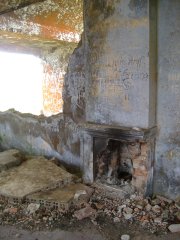 Overall the place is currently a bit of a "dump" - litter everywhere including on the beaches - but with clear signs of the development that will inevitably escalate over the next few years. Seafront property is already being earmarked for development and, no doubt, there is some money changing hands to ensure that it is allocated to everyone's advantage except the locals. It is clear that joined-up planning is not a priority and unless some co-ordination is applied could just be turned from a small dump into a big one.
Overall the place is currently a bit of a "dump" - litter everywhere including on the beaches - but with clear signs of the development that will inevitably escalate over the next few years. Seafront property is already being earmarked for development and, no doubt, there is some money changing hands to ensure that it is allocated to everyone's advantage except the locals. It is clear that joined-up planning is not a priority and unless some co-ordination is applied could just be turned from a small dump into a big one.
After two nights, we packed and moved on. The first half of the journey was on metalled roads and the second on a good dirt surface, obviously prepared for the laying of tarmac some time soon. New bridges were in course of construction all along the 50 km of road but with the rains about to start the road surface will probably deteriorate rapidly unless the tarmac layers are laid very soon.
Just before Kampot, we turned off and started to head up a rough track heavily eroded by tropical rains. There were occasional signs of the original tarmac surface of the road when originally constructed starting in 1917; the project took several years to complete and many Cambodian labourers died in the process. Today the road is passable with care in 4x4 vehicles and motorbikes. We saw three or four Toyota Camry cars on the way up and at the top but we weren't sure how they'd managed to negotiate the large rocks exposed by the erosion of rainwater which regularly slowed our trip. Some previous attempts hadn't been so lucky as we saw two separate long streaks of black engine oil marking the centre of the track where, presumably, a sump had bottomed out on one of the rocks and cracked.
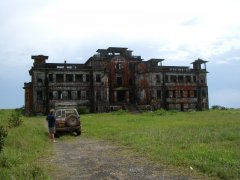 At the top of this track, the old French hill station of Bokor at 1080m is known for its cool climate, secluded waterfalls and jungle vistas. With the completion of the road, a small community was established that included a grand colonial hotel - the Bokor Palace - inaugurated in 1925. The hill station was twice abandoned: first when Vietnamese and Free Khmer forces overran it in the late 1940s while fighting for independence against the French, and then in the early 1970s when it was left to Khmer Rouge forces that were steadily taking over the countryside. It has since remained uninhabited, save for the presence of either Vietnamese troops or Khmer Rouge guerrillas during much of the '80s and '90s.
At the top of this track, the old French hill station of Bokor at 1080m is known for its cool climate, secluded waterfalls and jungle vistas. With the completion of the road, a small community was established that included a grand colonial hotel - the Bokor Palace - inaugurated in 1925. The hill station was twice abandoned: first when Vietnamese and Free Khmer forces overran it in the late 1940s while fighting for independence against the French, and then in the early 1970s when it was left to Khmer Rouge forces that were steadily taking over the countryside. It has since remained uninhabited, save for the presence of either Vietnamese troops or Khmer Rouge guerrillas during much of the '80s and '90s.
The place was fascinating and had a genuine ghost-town feel; the old Catholic church looked like it was locked up only yesterday. Inside, the altar remains intact and drawings of what appear to be Khmer Rouge fighters adorn the wall. The old hotel, Bokor Palace, was eerie and atmospheric. From what was once an outdoor terrace, there is a magnificent view over dense jungle stretching almost to the sea. It is possible to wander from the basement, up and down the corridors and through the ballroom to the suites above, imagining what the hotel was like in its heyday when it must have been very grand. Other buildings dotted around include an old casino, an abandoned post office, which looks like it has taken a mortar at some stage in its history, and an old water tower. Surrounding this building and all the others in the vicinity was the worst litter we had so far seen. Why couldn't some of our $5 a head admission fee be used to clean up? Labour's cheap enough here.
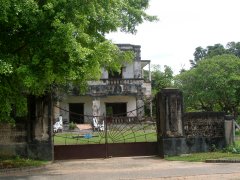 The 30+ km journey down, as for the journey up, took about 11/2 - 2 hours because of the state of the road. On the way up we were delayed for several km by other slower vehicles but were luckier on the way down. I was very glad that Martin was driving rather than me as the concentration required to identify the lumps, bumps and potholes was intense. He admitted to being relieved when we were back down and got onto reasonable roads. He did an excellent job - I must have done a pretty good job when I taught him to drive 18 years ago!
The 30+ km journey down, as for the journey up, took about 11/2 - 2 hours because of the state of the road. On the way up we were delayed for several km by other slower vehicles but were luckier on the way down. I was very glad that Martin was driving rather than me as the concentration required to identify the lumps, bumps and potholes was intense. He admitted to being relieved when we were back down and got onto reasonable roads. He did an excellent job - I must have done a pretty good job when I taught him to drive 18 years ago!
Next stop was to be Kampot. Lonely Planet describes Kampot as a "sleepy riverside town" a "charming place with a French architectural legacy and a relaxed atmosphere". We beg to differ. Kampot suffers from the same problems as Sihanoukville in that it is run down, untidy and uncared for - and our hotel turned out to be in the noisiest part of town. It is well known for producing some of the best pepper in the region but we didn't see any. The market was closed when we went there. In the years before war took its toll, no self-respecting French restaurant worth its salt in Paris would be without Kampot pepper on the table.
Having been disappointed with what we had seen so far along the Cambodian Riviera, we had decided to make our way back to Phnom Penh after only one night in Kampot. However, before getting onto the road back to the capital, we diverted to Kep, about 35 km along the coast.
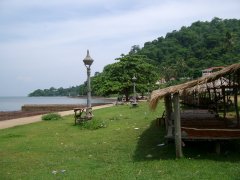 Kep is a reminder of the devastation and destruction delivered on Cambodia during the long years of civil war. The seaside resort of Kep was founded as a colonial retreat for the French elite colonials in 1908. Cambodian high rollers continued the tradition, flocking here to enjoy gambling and water sports. The war was not kind to Kep and little remains except skeletons of buildings. What wasn't dismantled by the Khmer Rouge was looted by the Vietnamese 'liberators', or by locals selling materials to the Vietnamese in order to survive the 1979-80 famine.
Kep is a reminder of the devastation and destruction delivered on Cambodia during the long years of civil war. The seaside resort of Kep was founded as a colonial retreat for the French elite colonials in 1908. Cambodian high rollers continued the tradition, flocking here to enjoy gambling and water sports. The war was not kind to Kep and little remains except skeletons of buildings. What wasn't dismantled by the Khmer Rouge was looted by the Vietnamese 'liberators', or by locals selling materials to the Vietnamese in order to survive the 1979-80 famine.
Wherever one drives in Kep one sees evidence of the wide streets built during its heyday. Today little is left but small dusty tracks with vegetation taking over the sides of the original roads. Down by the beach, if you ignore the crude shelters erected by the vendors, one can see the vestiges of an opulent promenade, with ornate street lights. The beach itself is rather scruffy consisting of a spread of jagged rocks, but it never was a natural sandy bay - before the war, white sand was shipped in from Sihanoukville. Another sad example of the results of internal conflict.
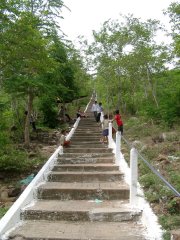 And so we headed back to Phnom Penh. On the way, we diverted again, his time to Phnom Chisor. This consists of a small temple from the pre-Angkorian era built on top of a hill. 418 steps lead up to the top and with temperatures still in the mid-30s, that's a long way. We set off, with plenty of water only to be surrounded by a crowd of local children. We found that where foreign visitors are comparatively few, tactics had changed from what we'd seen at all the Angkor sites. Once they had "claimed" us, they weren't about to let us go and tagged along, getting in our way and insisting in pointing out the obvious - e.g. telling us we'd reached the 200th step when it was painted on the step in figures a foot high. They wouldn't be put off even when we spoke quite sharply at them. I could see that Martin was getting really quite angry with them. I admit to being very irritated myself despite my recent refresher training in being patient with kids, courtesy of my three lovely grandchildren.
And so we headed back to Phnom Penh. On the way, we diverted again, his time to Phnom Chisor. This consists of a small temple from the pre-Angkorian era built on top of a hill. 418 steps lead up to the top and with temperatures still in the mid-30s, that's a long way. We set off, with plenty of water only to be surrounded by a crowd of local children. We found that where foreign visitors are comparatively few, tactics had changed from what we'd seen at all the Angkor sites. Once they had "claimed" us, they weren't about to let us go and tagged along, getting in our way and insisting in pointing out the obvious - e.g. telling us we'd reached the 200th step when it was painted on the step in figures a foot high. They wouldn't be put off even when we spoke quite sharply at them. I could see that Martin was getting really quite angry with them. I admit to being very irritated myself despite my recent refresher training in being patient with kids, courtesy of my three lovely grandchildren.
Having got to the top, we were greeted by the sight of some tumbledown vendors' stalls and a sad and ill-preserved Buddha surrounded by an "ornamental" pool covered in green scum. To add insult to injury, they tried to stiff us for $2 a head to go on to the temple. If there were any sign that the admission charges were being used to preserve the site we might have agreed, but we politely declined and walked all the way back down. Towards the bottom, the children started begging for money and made it clear from the looks on our faces that they thought we were unreasonable by refusing.
And then it was Phnom Penh again. We returned to the same hotel we'd stayed at before. To his delight Martin discovered that we had a direct network link to the Internet in our new room and took the opportunity to catch up with a variety of tasks. Come the "Cocktail Hour", we made our way a short distance along the street to a bar/restaurant popular with the ex-pats in the city for sitting on the balcony to watch the sunset and the world go by in the street below. We were joined by Rachel, a friend Martin had made while in northern Thailand, who happened to have moved on the Phnom Penh. A couple of drinks later we accompanied her to an excellent Vietnamese restaurant specialising in noodle soup. It came in an enormous bowl, was a delicious meal in itself and the bill for three was less than we'd been paying for just the two of us. Thank you Rachel, for introducing us to that.
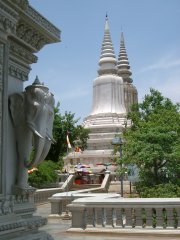 The next day we headed towards Battambang in the NW of Cambodia and within striking distance of the Thailand border. Again, we had planned a short diversion, this time to Udong. The guidebook plays this site down, in our opinion unjustly.
The next day we headed towards Battambang in the NW of Cambodia and within striking distance of the Thailand border. Again, we had planned a short diversion, this time to Udong. The guidebook plays this site down, in our opinion unjustly.
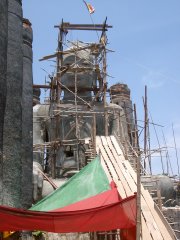 Udong served as the capital of Cambodia from the early 1600s to the late 1800s and a number of kings were crowned here. There are two ridges rising from the unrelenting flatness surrounding them. We scaled the larger of the two having thrown the crowd of kids off our tail by jumping back in the car and driving a short way along the ridge before getting back out of the car and quickly disappearing up the steps before anyone had time to realise we were there. There are several large stupas and some small temples on the ridge and at one end a huge statue of Buddha in the remains of a large temple dedicated by King Sisowath in 1911. Much of the temple was destroyed by the Khmer Rouge in 1977 and the Buddha statue was damaged. We were pleased to see that renovation work has started on the statue despite there being no admission fee to the site.
Udong served as the capital of Cambodia from the early 1600s to the late 1800s and a number of kings were crowned here. There are two ridges rising from the unrelenting flatness surrounding them. We scaled the larger of the two having thrown the crowd of kids off our tail by jumping back in the car and driving a short way along the ridge before getting back out of the car and quickly disappearing up the steps before anyone had time to realise we were there. There are several large stupas and some small temples on the ridge and at one end a huge statue of Buddha in the remains of a large temple dedicated by King Sisowath in 1911. Much of the temple was destroyed by the Khmer Rouge in 1977 and the Buddha statue was damaged. We were pleased to see that renovation work has started on the statue despite there being no admission fee to the site.
Finally we continued on our way to Battambang, found a hotel and a meal and eventually retired to bed for the night. The next day we went on a quick tour of the local market for suitable picnic food for lunch - very good bread (legacy of the French being in the region), mangoes and lychees then headed off to some places of interest south of the town.
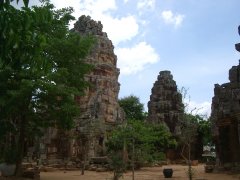 The first stop was Wat Banan, another temple on the top of a hill sprouting out of the flatness of the plain. There were only 358 steps to the top this time but progressively getting steeper and steeper. To our relief, this time our retinue consisted of only one small boy who kept his distance. He gave the impression he really didn't want to be there and we suspect he had been sent by a parent or the local "Fagin" to whom he'd have had to hand over the money, if we'd given it. No fee was charged at this site and again there were signs of maintenance. The Wat at the top is reminiscent of Angkor Wat but on a tiny scale by comparison. It was built in the 11th century and could well have been the inspiration for Angkor Wat. Views from the top are impressive out over the surrounding countryside.
The first stop was Wat Banan, another temple on the top of a hill sprouting out of the flatness of the plain. There were only 358 steps to the top this time but progressively getting steeper and steeper. To our relief, this time our retinue consisted of only one small boy who kept his distance. He gave the impression he really didn't want to be there and we suspect he had been sent by a parent or the local "Fagin" to whom he'd have had to hand over the money, if we'd given it. No fee was charged at this site and again there were signs of maintenance. The Wat at the top is reminiscent of Angkor Wat but on a tiny scale by comparison. It was built in the 11th century and could well have been the inspiration for Angkor Wat. Views from the top are impressive out over the surrounding countryside.
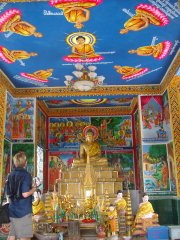 On to Wat Phnom Sampeau next which is a temple set on the top of a striking limestone outcrop. It was formerly the front line in the Government's defence of Battambang in the civil war. While there were steps leading to top it was much higher than anything else we'd visited so far and we were relieved to find that there was a concrete road which took us nearly to the top. The hill is topped by a small Wat and stupa. Just down the hill, were a couple of field guns left over from the civil war. Nearby there is another large hill which was often occupied by the Khmer Rouge and from the top of which they would fire shells at the defending government troops defending Wat Phnom Sampeau.
On to Wat Phnom Sampeau next which is a temple set on the top of a striking limestone outcrop. It was formerly the front line in the Government's defence of Battambang in the civil war. While there were steps leading to top it was much higher than anything else we'd visited so far and we were relieved to find that there was a concrete road which took us nearly to the top. The hill is topped by a small Wat and stupa. Just down the hill, were a couple of field guns left over from the civil war. Nearby there is another large hill which was often occupied by the Khmer Rouge and from the top of which they would fire shells at the defending government troops defending Wat Phnom Sampeau.
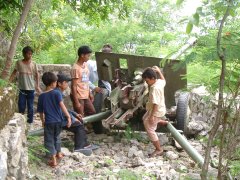 The next day, we set off for the border. We had opted for a more southerly route than we'd come into Cambodia by and knew that the road would be even worse than we'd experienced on the way in, but the route would be significantly shorter overall. Everything went well for the first half but then the road surface got progressively worse and we had to pick our way round the holes in the bridges. On top of this, it started raining. The rain did provide our one final bit of entertainment before leaving the country though.
The next day, we set off for the border. We had opted for a more southerly route than we'd come into Cambodia by and knew that the road would be even worse than we'd experienced on the way in, but the route would be significantly shorter overall. Everything went well for the first half but then the road surface got progressively worse and we had to pick our way round the holes in the bridges. On top of this, it started raining. The rain did provide our one final bit of entertainment before leaving the country though.
On the way in we noticed and remarked on the appearance of "filling stations" by the side of the road where petrol was being sold in plastic drinks bottles. On our way out we came across two of the suppliers who clearly had smuggled cans of fuel across the border from Thailand. They were riding two of the small 100cc motorbikes which are so common everywhere in Cambodia. They had so many cans of fuel strapped on the back that the front wheel must have been verging on a permanent "wheelie" position. Of course, as the rain on the earth road made the surface slippery, their bikes became well nigh uncontrollable and we spent 10 minutes watching as they tried to retrieve one of the bikes which had tipped over backwards on a narrow bridge.
Once they had cleared the obstruction we were able to get past and I was greeted by an enormous grin when I took a photo of one of the overloaded bikes on the way past. The rider was clearly none the worse for his spill. Apart from taking a wrong turning at one stage, the rest of the journey passed without incident and we passed out of Cambodia and into Thailand.
| All content copyright � overland-underwater.com - please do not use without permission. |
| Comment from Ant |
| That hotel sounds like 'The Shining' in a hot climate. I bet Martin couldn't resist doing a "Here's Johnny!" impression... |
| 28 Jun 2006 @ 16:49:22 |
